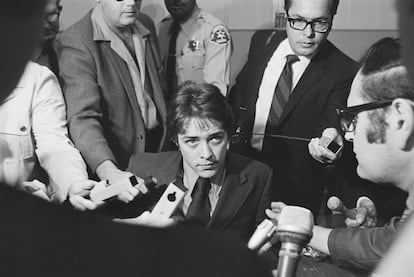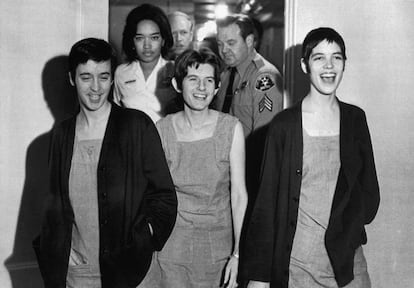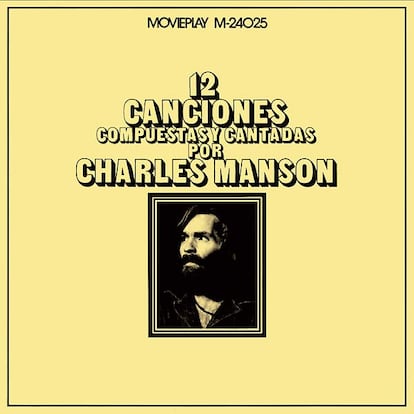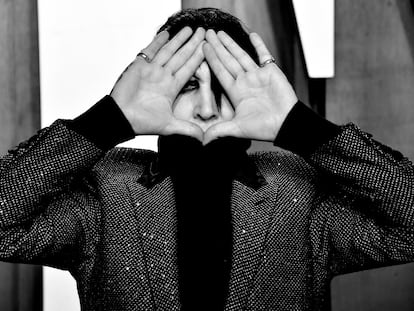The mysteries surrounding the Manson Family murders, more than half-a-century later: ‘I believe what I’m told to believe, don’t you?’
With an official thesis that’s disputed, the Tate-LaBianca killings continue to spark debate. The mastermind of the crimes died in 2017, but another relevant and even more mysterious figure remains in prison: the musician Robert Beausoleil

Less than five years had passed since the sentencing of Charles Manson and his criminal sect — the so-called “Manson Family” — when the official version of events was met with notable skepticism.
Truman Capote had become an authority on killers after the publication of In Cold Blood (1966), a book about the murder of a family in Kansas. He would go on to write a short story based on his 1972 interview with an imprisoned Beausoleil:
“Robert Beausoleil, who is now 31, is the real mystery figure of the Charles Manson cult. More to the point — and it’s a point that has never been clearly brought forth in accounts of that tribe — he is the key to the mystery of the homicidal escapades of the so-called Manson Family, notably the Sharon Tate-La Bianca murders.”
In the text — titled Then It All Came Down, published in the collection Music for Chameleons (1980) — Capote asserted that “it was out of devotion to ‘Bobby’ Beausoleil that Tex Watson and those cutthroat young ladies, Susan Atkins, Patricia Krenwinkel, Leslie Van Hooten, sallied forth on their satanic errands.”
In other words, the writer of the second-best-selling true crime novel didn’t believe what was said in the first: Helter Skelter: The True Story of the Manson Murders (1974). In this book, the prosecutor for the case — Vince Bugliosi — laid out the story that was endorsed by the courts.
On August 9, 1969, in Los Angeles, the Manson Family murdered the actress Sharon Tate — who was 26-years-old and eight-and-half months pregnant at the time — her three companions and another young man who was visiting the house next door. The cult then killed the LaBianca couple on August 10. According to Bugliosi, the motivation was that Manson had visions of an imminent war between Black and white people. The apocalyptic scenario was described — from Manson’s point of view — in the song Helter Skelter (1968), by the Beatles. Through the murders — which were designed to be attributed to the Black Panthers, with insults such as “pigs” painted on the walls of the house that was being rented by Shannon Tate and Roman Polanski — Manson intended to accelerate events. He and his followers would take refuge and, at the end of the race war, would supposedly emerge as leaders of the new world.
An almost identical murder had taken place on July 27, 1969. The victim was Gary Hinman — a musician associated with the Family — and the perpetrator was Robert Beausoleil, who was arrested on August 6. The motives ranged from a failed drug deal to a rumor — overheard by Beausoleil and his friend Manson — that Hinman had just inherited a large sum of money.
At the scene of the crime — committed via stabbing — the message “political piggy” and symbols of the Black Panthers were found in blood on the wall. For Capote, the motivation for the Tate-LaBianca murders was obvious: to confuse the authorities into thinking that the killer was the same and that, therefore, Beausoleil couldn’t be the culprit.
“The media, they called us a ‘family.’ And it was the only true thing they said,” Beausoleil scoffed, in his interview with the writer in prison, where he had become the leader of a neo-Nazi group, the Aryan Brotherhood. “If a member of our family was in jeopardy, we didn’t abandon that person. And so for the love of a brother, a brother who was in jail on a murder rap, all those killings came down.”
The credibility of Truman Capote — who famously took liberties while writing In Cold Blood — is questionable. As soon as he published his account of their meeting, Beausoleil denied that the transcript matched their conversation… although he too was far from reliable, given how many times he had changed his version of events over the decades. After refusing to cooperate for years, Beausoleil expressed remorse in the 1980s, although his drug story (he allegedly supplied bikers with bad mescaline that was sold to him by Hinman, which got him into trouble and provoked his revenge) never matched the testimonies of other members of the Family… except, occasionally, Manson’s version.

At 76, he has just completed 55 years in prison. All his requests for parole have been denied. He has taken responsibility for the crime and — in a 2019 article in Rolling Stone magazine, titled Bobby Beausoleil and the Last Manson Mystery — he stated that the theory that the Tate-LaBianca murders were conceived to free him was as absurd as the theory floated in Helter Skelter. “It had nothing to do with me. I didn’t command that kind of loyalty.” However, this was different from what he initially told Capote, when asked if he was under the influence of Charles Manson: “If anybody was influenced, it was him. By me.”
The copycat crime theory has gained weight over the years, as various researchers have questioned Bugliosi’s procedures and conclusions. It has even penetrated film and television: the Netflix thriller series Mindhunter (2017) addressed the hypothesis in an episode.
Beausoleil was active on the dark margins of 1960s Hollywood and the psychedelic scene. A disciple and lover of Kenneth Anger — the filmmaker and author of Hollywood Babylon (1959) — it was through him that he became familiar with the philosophy of the magician Aleister Crowley, which he was later able to transmit to Manson.
Beausoleil appears with Mick Jagger and the founder of the Church of Satan — Anton LaVey — in Anger’s short film Invocation Of My Demon Brother (1969), a cinematic incantation in the form of a mass, in which the convicted murderer plays the Devil. According to the journalist Jesús Palacios in his book Satan in Hollywood (1997), Anger’s refusal to give Beausoleil the same role in his next project — Lucifer Rising — ended their relationship.
In the following years, the director wore a voodoo medallion with the image of a frog and the inscription “Bobby Beausoleil changed into a frog by Kenneth Anger.” A masterpiece of underground experimentation and a visual translation of Crowley’s prophecies, Lucifer Rising was finally released in 1981… with music composed by Beausoleil from San Quentin State Prison. The soundtrack was performed by a dozen assassins.
When consulted by EL PAÍS, journalist Tom O’Neill sees it as an “implausible scenario” that the motivation for the Tate-LaBianca crimes was to free Beausoleil. In his book CHAOS: Charles Manson, the CIA, and the Secret History of the Sixties (2019), he questions the apparent arbitrariness of the murders and dismantles essential pieces of Bugliosi’s story. Far from the romantic vision of the inner-circle surrounding the marriage of Roman Polanski and Sharon Tate — established by Quentin Tarantino in Once Upon a Time in Hollywood (2019) — the author points out numerous links between the victims and their executioners, while describing a stormy everyday life. The journalist mentions a videotape recorded by Polanski, where Tate had violent sexual relations with two men. The authorities discovered the footage and returned it to the filmmaker, considering that it was part of his privacy. “Roman was a psychopath. He forced her to do it,” Vince Bugliosi confesses to O’Neill in the book. The former prosecutor partially omitted this detail in Helter Skelter.
“These people were a little scary. They had a reputation for being dangerous,” says Peter Bart, former editor-in-chief of Variety and an old friend of Polanski. In the book, the director of Rosemary’s Baby (1968) and hairdresser Jay Sebring — who was killed alongside Tate — are pointed out as key suspects in drug-trafficking and distribution in Hollywood. According to testimonies, the people in the house were high… and some claim to have seen Manson at at least one other party.
O’Neill challenges the belief that Manson was mistaken and actually wanted to murder the house’s previous tenant — producer Terry Melcher — out of revenge for not funding his music career. It has been established that Charles Manson knew that Melcher had moved out. Additionally, evidence has been presented which suggests that the prosecutor concealed an admission made by Melcher during questioning: that he had been at the Manson Family’s ranch after the murders. All of this cast doubt on the official story.

Beausoleil, however, maintains that Manson was aiming to kill Melcher, not Tate. “At one point, I was in a holding cell with Charlie and I said something to him like, ‘What the fuck?’ He’d never admit that he did anything wrong, but he got this embarrassed look. ‘I sent Tex to kill Terry,’ he said. And then the whole thing blew up in his face,” he recounted, in his final interview with Rolling Stone.
In another part of CHAOS, the focus shifts to the Haight-Ashbury Free Clinic, the epicenter of the Summer of Love — that of 1967, the peak of the hippie movement — where addiction treatments and LSD experiments were carried out for research purposes. Manson is known to have passed through this site, as did Abigail Folger, one of the people murdered on August 9, 1969. But O’Neill stresses to EL PAÍS that, although they may have overlapped, “it was never proven” that they interacted directly.
Born from a 1999 freelance assignment for the American magazine Premiere, the book is the result of an article that never saw the light of day. The journalist became absorbed in the investigation and dedicated 20 years to it. In the end, O’Neill produced a volume that, far from clarifying the facts, actually muddies them further. In the manner of a paranoid novel by Thomas Pynchon, he sketches an extravagant scheme that builds bridges between Manson’s crimes, the assassination of president John F. Kennedy and the CIA’s MKUltra mind control project, with the landscape of 1960s America as the backdrop. He also depicted the efforts of the intelligence services to deactivate the Berkeley student movement, the Black Panthers and the agitated climate that was developing.
Citing various sources, O’Neill places an alleged intelligence operative — Reeve Whitson — at the scene of the Tate murders before they became news. This illustrates how the authorities were monitoring the Manson Family well before the crimes, despite not making arrests until months later. O’Neill writes about a police official who claimed that Manson was an informant, hence justifying the freedom of movement he enjoyed, despite his criminal record.
No conclusion is definitive. But O’Neill’s narrative — at the very least — reinjects mystery and enhances the legend of crimes that had unfathomable social, cultural and political significance. Even today, there’s an echo of the events in the popular horror film Longlegs (2024).
James Buddy Day — the last journalist to speak with Manson before he died — dedicated the film Charles Manson: The Final Words (2017) and the book Hippie Cult Leader (2019) to the case, where he expounded a unified theory. Day believes Beausoleil and his explanation that he killed Hinman because he had cheated him with cheap mescaline… just as he observes that Manson feared reprisals from anti-racist activists after having shot a Black drug dealer named Bernard Crowe.
According to Day, the cult leader implemented a dual-strategy: involving as many people around him as possible in violent actions (which were also economically motivated) to prevent tip-offs, while also littering the crime scenes with confusing elements, so as not to be caught. This included false clues — a pair of glasses with no owner was deliberately left at Tate’s house — or delirious messages, elevated to gospel by Vince Bugliosi in Helter Skelter.
“I believe what I’m told to believe, don’t you?” Manson snarls, at a tense moment in the documentary, as unwilling to collaborate as ever. Upon dying, he would become a blank canvas, where one can project everything imaginable… or project nothing and face absolute emptiness.
Sign up for our weekly newsletter to get more English-language news coverage from EL PAÍS USA Edition
Tu suscripción se está usando en otro dispositivo
¿Quieres añadir otro usuario a tu suscripción?
Si continúas leyendo en este dispositivo, no se podrá leer en el otro.
FlechaTu suscripción se está usando en otro dispositivo y solo puedes acceder a EL PAÍS desde un dispositivo a la vez.
Si quieres compartir tu cuenta, cambia tu suscripción a la modalidad Premium, así podrás añadir otro usuario. Cada uno accederá con su propia cuenta de email, lo que os permitirá personalizar vuestra experiencia en EL PAÍS.
¿Tienes una suscripción de empresa? Accede aquí para contratar más cuentas.
En el caso de no saber quién está usando tu cuenta, te recomendamos cambiar tu contraseña aquí.
Si decides continuar compartiendo tu cuenta, este mensaje se mostrará en tu dispositivo y en el de la otra persona que está usando tu cuenta de forma indefinida, afectando a tu experiencia de lectura. Puedes consultar aquí los términos y condiciones de la suscripción digital.
More information
Archived In
Últimas noticias
Welcome to the post-religion era: The idea of Christianity as the absolute truth has become obsolete
‘I thought you would like it’: The risky sexual practice popularized by TV shows and TikTok
The digitalization of tourism: ‘They promise experiences and gave us the worst possible one’
Mexican peso defies uncertainty with forecasts of a new period of stability in 2026
Most viewed
- Sinaloa Cartel war is taking its toll on Los Chapitos
- Reinhard Genzel, Nobel laureate in physics: ‘One-minute videos will never give you the truth’
- Oona Chaplin: ‘I told James Cameron that I was living in a treehouse and starting a permaculture project with a friend’
- Why the price of coffee has skyrocketed: from Brazilian plantations to specialty coffee houses
- Silver prices are going crazy: This is what’s fueling the rally











































